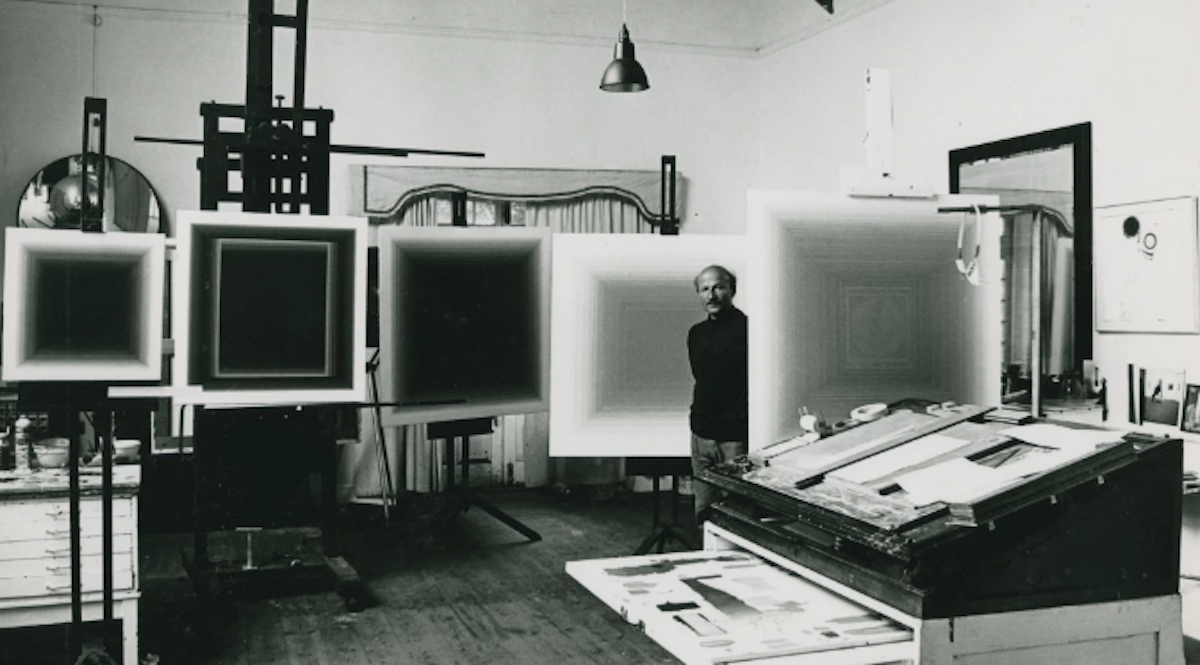The Redfern Gallery will celebrate the centenary of the artist Paul Feiler with a comprehensive retrospective of works (1918-2013) Elusive Space: A Centenary Retrospective will run concurrently with Catharine Armitage: The Way She Sees It. Armitage, Feiler’s widow, who painted alongside the artist for many years, will present a new series of paintings in the lower gallery.
“I could almost taste the quality of” Feiler’s depiction of sand in the seascapes – Peter Lanyon
The exhibition forms part of a series of events curated throughout 2018 to mark 100 years since Paul Feiler’s birth, including the launch of a new monograph published by Lund Humphries; a significant museum retrospective Paul Feiler: One Hundred Years at the Jerwood Gallery; as well as the acquisition by Tate of a key late painting Janicon LXII (2002).

Paul Feiler is one of the group of internationally renowned artists who lived and worked near St Ives during the 1950s and 60s, which included Peter Lanyon, William Scott and Roger Hilton. During his lifetime, Feiler was given two major retrospectives at Tate St Ives, and his work is displayed in its current exhibition, Modern Art and St Ives.
Elusive Space: A Centenary Retrospective will feature key works spanning varying stages of Feiler’s career. The artist’s paintings were often inspired by the cliffs and inlets of the coast of south-west Cornwall. A number of the earlier pieces seek to evoke the sensation of the landscape – of rain sweeping in from the west, the sea pounding the cliffs, the grey granite of harbour walls and houses, and the rapidly changing light. Pivotal works include Grey Receding (1964-65), Evening Harbour, Low Tide (1953) and Scathe, Brown (1963).
Peter Lanyon had described how he “could almost taste the quality of” Feiler’s depiction of sand in the seascapes. Lanyon added that Feiler achieves “a sense of calm and a sense of pause”.
In the late 1960s, Feiler moved from painterly abstraction to oils inspired by the lunar space landings. From the 1970s onwards, Feiler explored the elusive nature of space through a distinctive square format of narrow bands of colour, often incorporating silver and gold leaf. Based on the idea of a hidden shrine or sacred space, he continued to develop these ideas over more than 40 years. These later works were described by his friend Alan Davie as “some of the most mystical magic pictures I have ever seen”.
Additional highlights of his later work, not seen at the Jerwood Gallery retrospective, include Zenicon XXVIII (2007) and Square Relief VIII (2009), both showcasing his mixed media use of oil, emulsion, silver leaf, gold leaf, stainless steel and Perspex.

Running concurrently with the Feiler exhibition the Redfern Gallery will be presenting new works by Catharine Armitage highlighting her association with Paul Feiler, with whom she shared her life beginning in 1966, which triggered the greatest advances in her developing approach. In her discussion with him about painting and, especially her own painting, she began to free herself from the issues of naturalistic representation that had predominated in her earliest work in favour of the acknowledgement of the functions and basics of painterly relationships: what actually happens between forms and colours on the surface, and how these elements interact with or even create space.
Paul Feiler graduated from The Slade School of Art, from 1946 onwards, he taught at the West of England College of Art in Bristol, wherein 1960 he became Head of Painting. In 1953, with the proceeds of his first sell-out exhibition at The Redfern Gallery, Feiler bought a disused chapel near Penzance which he converted into a home. In 1973 he and his family moved permanently to Cornwall and, a year later, he took over his friend Bryan Wynter’s studio at Paul (originally used by Stanhope Forbes). During this time Feiler forged close friendships with many of the leading St Ives artists.
Feiler’s work is held in many public collections, including Tate; the Victoria and Albert Museum; Kettle’s Yard and the Arts Council. International collections featuring his work include the Gallery of Modern Art, Washington, DC; the Bibliothèque Nationale, Paris and the Toronto Art Gallery, Canada.
Catharine Armitage has lived and worked near Penzance in Cornwall for fifty years. Like her late husband Paul Feiler, Armitage finds inspiration from her surroundings, and is often drawn to glimpsed views or distorted perspectives. Created predominately over the past four years, the oil on canvas body of works explores Armitage’s interactions with the world around her. As Armitage states: “my paintings are reactions to the things I see; they are not about ideas.” Her observations are distilled into abstract shapes, contrasting organic and geometric forms: an Arp-esque landscape viewed through the basic structure of a window or door frame; the linear formation of a frozen lake or parallel rows of icicles on a railing; a particular colour or shape partially glimpsed through the slats of a wooden gate; or the simple contrast of light and shadow on walls and doors. As art scholar and author Marilyn McCully has said: “We discover qualities associated with her own responses: of stillness or tension, light and mystery, sensuality and emotion.”
Top Photo: Courtesy Redfern Gallery
Paul Feiler: Elusive Space A Centenary Retrospective26 September – 27 October 2018 – Catharine Armitage The Way She Sees It 26 September – 27 October 2018

